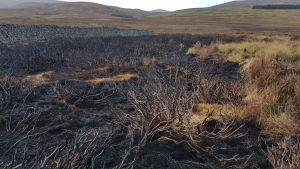The abundance of organic archaeological artefacts and paleoenvironmental evidence found in waterlogged environments exists largely because the lack of oxygen (caused by waterlogging) severely slows deterioration. For peatlands themselves, the negative consequences of losing this waterlogging through drainage and land use change are well documented. But what happens to the unique historic archive when these changes occur?
 Increasingly, case studies from across the UK are illustrating just how damaging changes in the environment can be to buried archaeological remains. Most recently, unprecedented levels of organic preservation at the Bronze Age site of Must Farm (East Anglia) were put at risk by the development of a nearby quarry1. Other examples of archaeological monuments at risk through land exploitation include in areas of intensive peat cutting in the Somerset and Humberhead Levels, and intensive land drainage across the East Anglian fens; regions which all hold an impressive array of archaeological monuments and sites2.
Increasingly, case studies from across the UK are illustrating just how damaging changes in the environment can be to buried archaeological remains. Most recently, unprecedented levels of organic preservation at the Bronze Age site of Must Farm (East Anglia) were put at risk by the development of a nearby quarry1. Other examples of archaeological monuments at risk through land exploitation include in areas of intensive peat cutting in the Somerset and Humberhead Levels, and intensive land drainage across the East Anglian fens; regions which all hold an impressive array of archaeological monuments and sites2.
One of the most striking examples of land modification affecting archaeology is the Mesolithic site of Star Carr (North Yorkshire). For over 10,000 years, organic artefacts and environmental remains had been exceptionally well-preserved at the site due to their deposition at the edge of a lake which subsequently became blanket peat. Organic artefacts dating from the Mesolithic are rare, but finds from Star Carr include head-dresses made from red deer skulls (left), worked wooden timbers, and bone and antler tools3. In addition, when it was first excavated in the 1940’s, the study of plant remains and pollen allowed the site to be interpreted in the context of its original landscape, providing a huge amount of information about human activity during this time.
However, following intensified drainage of the Star Carr field in 2000 AD, hydrological monitoring indicated that the water-table had started to lie below the archaeological layers for much of the year4. The consequences of this for the remains preserved in the peat were rapid and irreversible. Changes in the water-table led to acidification, dissolving bone and antler objects, and subsequent shrinkage of the peat led to the compression of worked timbers. A decision was eventually made to fully excavate the site, retrieving what information remained.
Research at Star Carr demonstrated just how quickly the historic archive can be affected by changes in the environment: loss was being observed within years, not decades. It’s often assumed that archaeological objects are better left where they are as the costs and scale of excavation and conservation can be hugely prohibitive. In addition, once they are excavated, organic remains immediately start to dry out and change, potentially losing their archaeological significance. However, these recent case studies as well as others from across the UK and worldwide, serve to illustrate that we must also be aware of how changes in the environment can put buried remains at risk from complete loss.
Images: (Top) Red deer antler head-dress from Star Carr, one of nearly 30 now found. (Image from the Scarborough Collections courtesy of Scarborough Museums Trust) (Bottom) A replica of the Neolithic 'Sweet Track' stretching for 2 km across the Somerset Levels. Large areas of the real trackway are located in areas of peatland that have undergone intensive drainage.
Dr Kirsty High, University of York
References
1. French, C. (2017). Some thoughts on the monitoring and preservation of waterlogged archaeological sites in eastern England. Wiley Interdisciplinary Reviews: Water, 4(3), e1204.
2. Brunning, R. et al. (2012). Somerset's Peatland Archaeology: Managing and Investigating a Fragile Resource. Oxbow.
3. Milner, N et al. (2013) Star Carr: Life in Britain after the Ice Age. Archaeology for All
4. Brown, T. et al. (2011). Hydrological assessment of Star Carr and the Hertford catchment, Yorkshire, UK. Journal of Wetland Archaeology, 11(1), 36-55.










